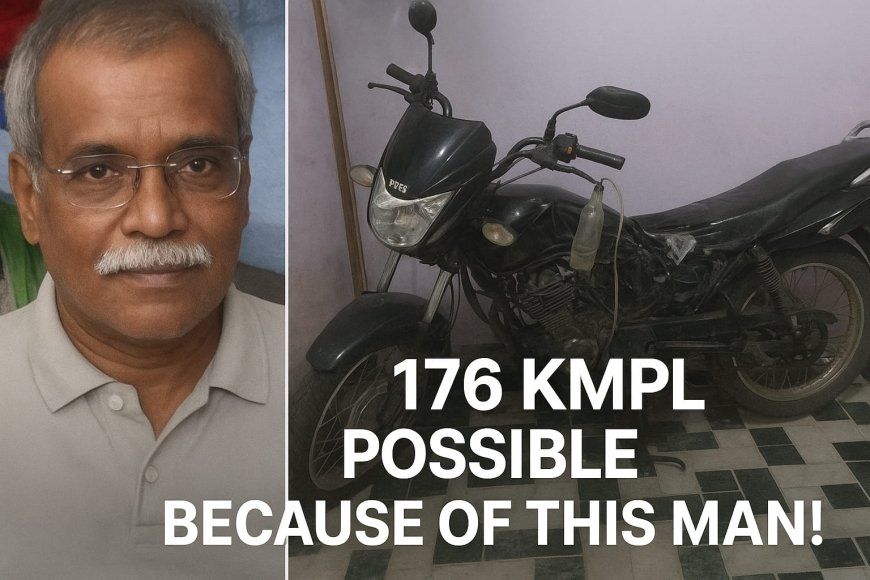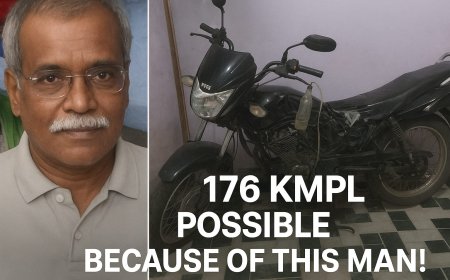Meet the Indian Inventor Behind the 176 Km/Litre Six-Stroke Engine
Discover how Shailendra Singh Gaur’s six-stroke engine delivers 176 km per litre with near-zero emissions. Learn about his journey, innovation, patents, and why this breakthrough could transform fuel efficiency and green mobility in India.

If there’s one thing Indians talk about as much as traffic, it’s fuel prices. Every extra kilometre squeezed from a litre feels like a small victory. Now picture a bike that doesn’t give 40 or 50 km per litre, but a staggering 176 km in 1 litre of petrol, while producing almost no pollution. Sounds unbelievable?
That’s exactly what Shailendra Singh Gaur, an innovator from Allahabad, has achieved after dedicating nearly two decades to reinventing how engines work. He developed a six-stroke engine that could transform transportation in India.
The Man Behind the Machine
Shailendra Singh Gaur isn’t the kind of engineer who climbed the corporate ladder in a big company. He studied Physics, Chemistry, and Mathematics at Allahabad University, graduating in 1983.
In 2007, Tata Motors offered him a job. For most, that would have been the dream. But Gaur wanted something bigger. He chose to dedicate his life to building an engine that could cut fuel use and reduce pollution.
To make it happen, he sold his own property and turned his rented home into a laboratory. For 18 years, he experimented, tested, and refined his idea. Along the way, he collaborated with experts at MNNIT and later IIT-BHU.
The sacrifices were enormous, but the result proved worth it.
What Sets the Six-Stroke Engine Apart
To see why this is special, let’s look at the basics. Conventional vehicles use four-stroke engines: intake, compression, power, and exhaust. This system has worked for over a century, but it’s wasteful. On average, only about 30 percent of the fuel’s energy is converted into power. The rest escapes as heat and emissions.
Gaur added two more steps to the process: An extra expansion stroke, which squeezes more energy out of the fuel, and an extra exhaust stroke, which clears leftover gases.
With this tweak, the engine can use up to 70 percent of the fuel’s energy. This level of performance is more than twice what traditional engines achieve. The result is higher mileage and far less pollution.
Proof on the Road
Big claims don’t mean much without evidence. Gaur’s six-stroke engine has already been tested.
When fitted on a 100cc TVS bike, the engine kept it running for 35 minutes with only 50 ml of petrol. That’s equivalent to 176 km per litre. Almost no unburnt fuel escapes, resulting in near-zero carbon emissions.
In live demonstrations and television programs, where conditions weren’t as controlled, the bike still reached around 120 km per litre. For comparison, most standard bikes in India manage 40 to 50 km per litre.
Experts who observed the trials confirmed what the numbers showed: the engine delivered roughly three times the efficiency of a regular one.
The Technical Edge
For those who like the details, here’s what makes this engine stand out:
1. Thrust angle: A regular engine operates at about 25°. Gaur’s design pushes it to 60°, pulling more power out of the fuel.
2. Fuel flexibility: It works not only on petrol but also on diesel, CNG, and ethanol.
3. Heat control: Better combustion cuts down heat loss, keeping silencer temperatures lower.
4. Cleaner output: With maximum fuel utilization, the engine leaves behind only trace amounts of carbon emissions.
It’s rare to find a design that scores on both performance and environmental benefits.
Recognition and Reach
This innovation hasn’t gone unnoticed. Gaur has secured two Indian patents for the six-stroke engine, and his work has been featured in newspapers, television shows, and across social media.
The most exciting part? This isn’t limited to motorcycles. The same design can be adapted for cars, buses, trucks, and even ships. A technology like this could save millions of litres of fuel and make transport significantly cleaner.
Why It Matters
Its significance isn’t limited to mileage alone. It has various other benefits:
1. Cleaner cities: With negligible emissions, urban air quality could improve dramatically.
2. Lighter bills: If vehicles consume one-third the fuel, monthly expenses drop sharply.
3. National savings: Reduced demand for petrol and diesel means less dependence on imported crude oil.
4. Global leadership: If the technology is refined and brought into mass production, India could stand out as a global hub for green vehicle engineering.
The Challenges Ahead
As with many breakthroughs, the hardest part isn’t invention; it’s adoption. Scaling up production requires industry backing, government support, and investment. Without that, the six-stroke engine risks remaining an underappreciated experiment instead of a global success.
Gaur continues to push for recognition and support. His vision is clear: six-stroke engines powering everything from bikes to buses, making transport cheaper for families and cleaner for the environment.
Final Thoughts
Here’s what makes this story remarkable. One man, working out of a modest setup in Allahabad, chose persistence over security and spent nearly two decades chasing a dream. The result is a machine that could reduce fuel costs, cut emissions, and shift India’s automotive future.
The six-stroke engine is more than just a technical innovation. It’s a reminder that breakthrough ideas can come from unexpected places, powered not by giant corporations but by individuals willing to sacrifice for a vision.
If supported, Shailendra Singh Gaur’s invention could redefine mobility in India. And with fuel prices showing no signs of dropping, who wouldn’t want a bike that takes you 176 km on a single litre?
What's Your Reaction?
 Like
0
Like
0
 Dislike
0
Dislike
0
 Love
1
Love
1
 Funny
0
Funny
0
 Angry
0
Angry
0
 Sad
1
Sad
1
 Wow
1
Wow
1


























































































